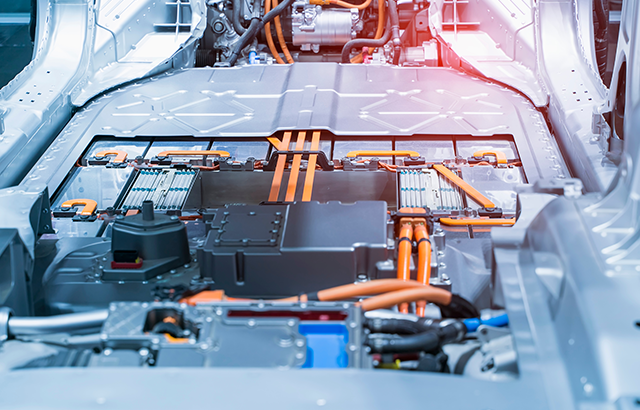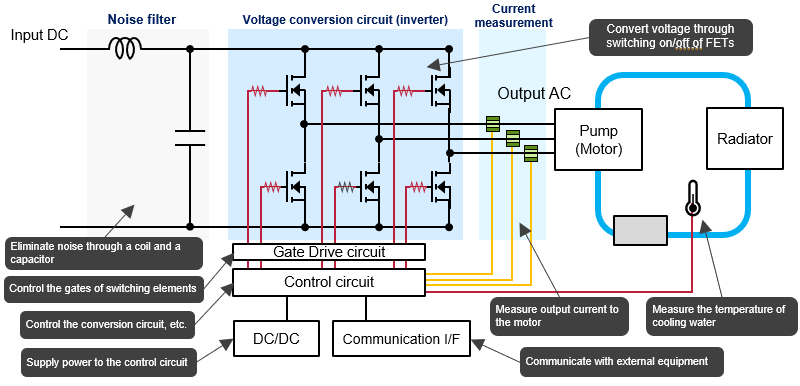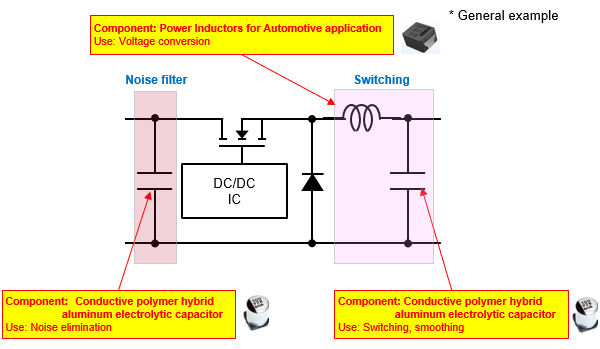What Is the Cooling System Pump?
- Circulate Water to Curb Heating of Equipment -
2024-4-22

The pump of a cooling system creates a water flow in the cooling system that circulates water to curb heating of equipment. This device needs a power supply from 30 W to 100 W to operate. The pump is composed of an impeller, a motor, and an inverter, which are put together inside an outer casing; typically, a cylindrical shape. This article discusses the functions and system configuration of the pump and introduces electronic components making up the pump as well.
1. What Is the Cooling System Pump?
The cooling system incorporated in a vehicle is designed to curb heating of various pieces of equipment, such as the battery and motor. The cooling system cools heat-carrying equipment by circulating water though pipes running in the cooling unit (jacket) of the equipment. What the pump does, is force water to flow through these pipes. Generally, the operating power of the pump ranges from 30 W to 100 W. The pump is made up of a mechanism section including an impeller and a motor, an inverter (motor controller) that controls the motor, and a circuit board. These components are put together inside an outer casing; typically, a cylindrical shape.

2. Trends in the Market and Demand for Cooling System Pump
It is expected that an increase in the number of cars, including EVs and gas vehicles, running on the internal combustion engine (ICE) will lead to an increase in the number of pumps incorporated in those cars. In addition, various pieces of equipment (battery, on-board charger, inverter, etc.) with increasing power output tend to generate more heat. This has led to a demand for a cooling system with improved cooling performance and a pump with higher output.
Hence electronic components making up the cooling system need these essential features - "large current flow," "low loss," "high heat resistance," and "high precision (temperature)."
3. Circuit Configuration of a Cooling System Including the Pump
3-1. Overall configuration
- Noise filter:Eliminates noise through a coil and a capacitor.
- Voltage conversion circuit:Converts voltage by switching elements, such as FETs.
- Current measurement unit:Measures the output voltage to a motor.
- Gate drive circuit:Controls the gates of the switching elements.
- Control circuit:Controls the conversion circuit, etc.
- DC/DC converter:Supplies power to the control circuit.
- Communication I/F:A circuit that communicates with external equipment.

4. Individual Circuits and Components
4-1. Noise filter
The noise filter suppresses internal noise or noise from external equipment, thereby preventing malfunctioning of the system. In general, the filter combines a large coil and a capacitor together.
Noise elimination and smoothing: Conductive polymer hybrid aluminum electrolytic capacitor
POINT- ❶ The capacitor offers high capacitance, low ESR, and high ripple-suppression performance, thus contributing to a reduction in the size of the circuit and an increase in the power capacity (low voltage and large current) of the circuit.
- ❷ Having capacitance characteristics that can cut off high-frequency components, the capacitor eliminates a wide range of high-frequency noises that are generated by a high-frequency switching of the circuit.
Voltage conversion: Power Inductors for Automotive application
POINT- ❶ Inductors made of a metallic magnetic material suffer less power loss and carry a large current, thus contributing to a reduction in the size of the circuit and an increase in the power capacity (low voltage and large current) of the circuit.
- ❷ Having loss characteristics in a higher frequency range (low ACR), the inductor contributes to the suppression of power loss caused by high-frequency switching of the circuit.
4-2. Voltage conversion circuit
The voltage conversion circuit converts voltage by switching elements. The switching elements switch on and off to make voltage conversion, but these switching actions create noise. To deal with this problem, the gate terminals of the switching elements (FETs) are provided with resistors that suppress the noise.
Suppressing gate-driven noise from the switching elements: Chip resistor (small and high-power chip resistor)
POINT- ❶ With its original resistance pattern, electrode structure, etc., the chip resistor is small in size and yet handles high-power operations, thus contributing to a reduction in the size of the circuit.
4-3. Control circuit
The control circuit constantly monitors the temperature of water circulating through the cooling system, using a water temperature sensor. According to the water temperature acquired by the sensor, it adjusts the rotating speed of the pump in the cooling system to pump out a proper amount of water, thereby keeping the system interior at the proper temperature.
Monitoring water temperature: Temperature sensor (Automotive use)
POINT- ❶ With an over-molded structure, the temperature sensor offers high water resistance and the best heat resistance in the industry (which allows the sensor to withstand temperatures ranging from -40°C to 200°C).
4-4. DC/DC converter
The DC/DC converter is composed mainly of an FET, a coil, and capacitors. In the DC/DC converter, generally, conductive polymer hybrid aluminum electrolytic capacitors are used to eliminate noise at the input end and to smooth voltage output at the output end, and an in-vehicle power inductor is used for voltage conversion.
Noise elimination, switching, and smoothing: Conductive polymer hybrid aluminum electrolytic capacitor
POINT- ❶ The capacitor offers high capacitance, low ESR, and high ripple-suppression performance, thus contributing to a reduction in the size of the circuit and an increase in the power capacity (low voltage and large current) of the circuit.
- ❷ Having capacitance characteristics that can cut off high-frequency components, the capacitor eliminates a wide range of high-frequency noises that are generated by a high-frequency switching of the circuit.
Voltage conversion: Power Inductors for Automotive application
POINT- ❶ Inductors made of a metallic magnetic material suffer less power loss and carry a large current, thus contributing to a reduction in the size of the circuit and an increase in the power capacity (low voltage and large current) of the circuit.
- ❷ Having loss characteristics in a higher frequency range (low ACR), the inductor contributes to the suppression of power loss caused by high-frequency switching of the circuit.

4-5. Communication I/F
The communication I/F (communication circuit) communicates with external equipment through two communication lines (CAN, Ethernet, etc.). If noise or static electricity enters these communication lines, it may cause a transceiver IC to fail. To prevent such a problem, the transceiver IC is usually provided with chip varistors serving as electrostatic control measures.
ESD noise elimination: Chip varistor
POINT- ❶ With a wide range of capacitance characteristics, the chip varistor suppresses electrostatic discharge (ESD) noise while keeping the communication quality of the circuit intact.
- ❷ With its capacitance ranging from 8 pF to 250 pF, the chip varistor operates effectively at low and high communication speeds.

5. Summary
The cooling system circulates water to cool equipment, thereby curbing heating of the equipment. It is expected that an increase in the number of cars, including EVs and gas vehicles running on the ICE, will lead to an increase in the number of cooling systems and pumps incorporated in those cars. As the power output of various pieces of equipment increases, improved cooling performance of the cooling system is in great demand, therefore, a pump with higher output is needed, too. Hence, electronic components making up the cooling system need these essential features - "large current flow," "low loss," "high heat resistance," and "high precision (temperature)". Panasonic Industry offers a wide variety of products for use in the cooling system (Table 1).
| Component | Feature | High voltage |
Large current |
Low loss |
Small size |
High resistance to heat |
High precision |
|---|---|---|---|---|---|---|---|
 |
Low ESR High reliability |
✔ | ✔ | ✔ | ✔ | ✔ | |
 |
Low ESR High reliability |
✔ | ✔ | ✔ | ✔ | ||
 |
Large current, low loss High reliability |
✔ | ✔ | ✔ | |||
Chip varistor  |
High precision High resistance to heat |
✔ | |||||
| Temperature sensor (Automotive use)  |
High precision High reliability |
✔ | ✔ |
6. Related product information
7. Related information
8. Tags related to this article

